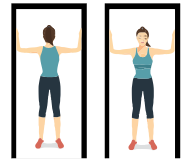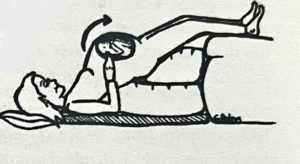The last few weeks of pregnancy are vitally important. Here are some suggestions for a mother during her final stages of pregnancy.
1. CRAWL ON ALL FOURS (HANDS AND KNEES) FOR FIVE TO TEN MINUTES, TWICE A DAY
This position allows optimum room for your baby to correctly place itself within your pelvis. This task is particularly beneficial if, upon abdominal examination, you find that your baby has rotated within your pelvis (into a posterior position, for example), or is yet to move down into your pelvis.
Posterior babies used to be uncommon in previous decades. It has been suggested that this is because women of these times would regularly scrub the floor on their hands and knees. This type of posture, with gravity’s assistance, encouraged babies to move anteriorly into the pelvis.
In preparation for birth we need to make a conscious effort to crawl around the house. If you feel inclined, embrace those ‘nesting urges and get down on your hands and knees and dust those neglected skirting boards and corners! Alternatively read a magazine or newspaper whilst on all fours.
2. KEEP AN UPRIGHT POSTURE
Avoid sitting in a reclined position (backward leanins) on the couch or in the ear, as these postures do not encourage correct positioning for your baby.
3. ENSURE YOUR SPINE IS ALIGNED FOR A MORE STRAIGHTFORWARD BIRTH
Due to hormonal changes and gravitational forces, pregnant women often develop specific subluxation and postural patterns. Research shows that correct alignment of the pelvis and spine contributes to a more straightforward labor with less pain and trauma for mother and child.
One particular subluxation pattern seen in pregnant women is the “Double PI Ilium/Sacral base posterior”. The pregnant mother tends to carry her head, drooping shoulders and whole upper body forward, decreasing the curve in her lower back. This results in head, neck, shoulder and back pain.
While not as commonplace as other patterns, according to Dr McCullen in her paper, Spinal Stabilization, “This type of subluxation pattern has more severe long-term consequences as the patient will be prone to protracted (long) labor, intense back pain during her labor and disordered uterine action (contractions that are inconsistent).”
Chiropractors can ensure that your spine is properly aligned and subluxation free, and regular visits while you are pregnant will diminish the chance of complications during labor.
4. PERFORM REGULAR PERINEAL MASSAGE
This is important, particularly if this is your first birth, or if you have suffered perineal tears with a previous birth. This massage, while at times painful and difficult, is one of the best methods for physically preparing the body for birth. Please ask us for our handout on perineal massage should you need techniques.
5. PERFORM PELVIC FLOOR STRENGTHENING EXERCISES
Keeping your pelvic floor strong at this late stage of pregnancy ensures quicker recovery post-birth.
A common complaint of new mothers is that no one tells them how heavy and sore their body can feel after a labor. There are few things worse than feeling as if you have to physically hold your pelvic floor as you climb a set of stairs.
So get busy with these strengthening exercises! Please ask us for our handout on pelvic floor exercises should you need techniques.
6. APPLY VITAMIN E OR JOJOBA OIL TO YOUR PERINEAL AREA DAILY
This activity helps to soften the area. If you are a new mother, your perineum has not had to stretch and accommodate for the passing of a small being before.
So help your body by encouraging elasticity. This will also be useful if you have previously experienced perineal tears.
7. APPLY OILS AND CREAMS ONTO YOUR STOMACH AND BREASTS TO HELP PREVENT STRETCH MARKS
It is beneficial to continue applying these lotions pre and post-birth, as your milk comes in and the breast tissue is further stretched.
8. BREAST MASSAGE IN THE LAST FEW WEEKS OF YOUR PREGNANCY HAS BEEN SUGGESTED BY SOME AUTHORS TO INCREASE MILK SUPPLY
With this massage you may experience some colostrum leakage; this is natural.
Knowing that you have abundant colostrum and breast milk available for your newborn instills great confidence in a new mum.
9. DRINK PLENTY OF RASPBERRY LEAF AND STINGING NETTLE TEA
These teas are available from health food stores. Use two handfuls of dre eaves and cover with boiling water in a litre jar, leave for four hours, strain and drink one cup per day. If making fresh, use three quarters of a teaspoon per cup.
Raspberry Leaf tea can be used alone or in combination with Squaw Vine, Beth Root and Blue Cohosh to help encourage a steady labor.
Stinging Nettle teas are rich in iron and vitamin K, which help to reduce the risk of hemorrhage and improve recovery post-birth. Nettles also help to reduce hemorrhoids as they are mildly astringent and strengthen blood vessel walls. Stinging Nettles are also beneficial during the first trimester.
Drink Raspberry Leaf tea regularly in the last six weeks of pregnancy as it is highly nutritious. Containing calcium, iron, folic acid and vitamin E, it prepares your body for birthing by helping to soften your cervix. Raspberry leaves consumed after labor also help milk production and hasten recovery of the uterus and pelvic area, post-birth.
10. BE PARTICULARLY MINDFUL OF YOUR DIET IN THESE LAST FEW WEEKS
In the last few weeks of pregnancy, focus on attaining enough vitamin C, B, E, K, iron, zinc and probiotics. Vegetarian mothers will also need to attain plenty of calcium and vitamin B12. Nothing beats getting these vitamins and minerals naturally from foods.
Some tips:
o Vitamin C – attained through good quality fruits and vegetables. Vitamin C is vital for fetal development and for a mother’s increased demands of collagen for her growing breasts and stomach. Furthermore, vitamin C helps with the rate of post-labor healing, boosts your immunity and aids the body’s ability to absorb iron (sustained iron levels are vital).
o Vitamins B – (in particular B2, B6, B9 and B12)-they may help to reduce the risk of both preeclampsia and intrauterine growth retardation.
o Vitamin E – firstly from your diet, then in supplement form. Vitamin E is a valuable antioxidant, it protects against hemorrhoids and varicose veins, normalizes blood pressure and aids delivery.
o Vitamin K- important for proper blood clotting and the prevention of hemorrhage.
o Zinc – this mineral helps prevent stretch marks, perineal tearing and cracked nipples, and is important for fetal growth. Including zinc-rich foods every day in your diet may also help to prevent birth defects.
o Iron-a pregnant mother’s diet should be rich in iron throughout her pregnancy, particularly in the last trimester. If this is your first pregnancy you may not need to take an iron supplement; with subsequent pregnancies, your blood tests may indicate lower iron levels and additional iron supplements (non-chelated) are required.
11. TRY BREATHING OUT WHEN HAVING A BOWEL MOTION
This helps a pregnant mother learn how to relax and release her pelvic floor.
12. HAVE A NAP EACH DAY
Adequate rest is important for both you and your growing baby.
“Take rest; a field that has rested gives a bountiful crop” Ovid (43BC-17AD)
13. CORRECT SLEEPING POSITION
It is recommended that once you know that your baby is correctly positioned towards the front of your uterus (best checked by your midwife), that you lie predominantly on the same side as your baby’s back to encourage him/her to stay in this same position.
As you lie on your side, place a small pillow underneath your pendulous belly (i.e. between your belly and the mattress). This helps to prevent the weight of your baby pulling your pelvis forward. Then place another smaller between four knees to assist correct alignment of your spine and pelvis.
14. VISUALIZE VS IDEAL POSITION OF YOUR BABY’S IDEAL POSITION FOR BIRTH
Visualize your baby’s position for birth:
o Head down
o With their chin tucked down onto chest
o Baby’s back to mum’s belly button
o Arms tucked down and against their body
15. PREPARE YOUR NIPPLES FOR BREASTFEEDING BY GENTLY PINCHING AND ROLLING THEM
These techniques help prevent nipples becoming too sore when first breastfeeding. These methods also familiarize a woman with handling her breasts and can be performed on both sides for two minutes a day in the last four to six weeks.
A mother can prepare her nipples by not wearing a bra and exposing the nipples to the gentle friction of clothes, also by exposing the nipples to sunlight for a few minutes a day. Rubbing the nipples with wheatgerm oil or expressed colostrum (late in pregnancy) is another important preparatory step.
Don’t rub your nipples with a towel or a brush in an attempt to toughen them, as this will merely rub off skin cells and leave your nipples tender. Also avoid washing your nipples with soap as this will cause them to dry out and promote cracking when they are later stretched.
TO PREPARE NIPPLES FOR BREASTFEEDING:
PINCHING: Using your thumb and forefinger, gently squeeze just behind the nipple. If your nipple does not protrude, gently pull them outward.
ROLLING: Once you have pinched, roll your nipple between your thumb and forefinger, gently stretching it forward out of your breast.
16. CONSIDER NOT TELLING YOUR FRIENDS AND FAMILY YOUR EXACT DUE DATE
Being vague about when you will reach your 40 weeks gestation can be very helpful, particularly if you do go over your due date. Remember that babies initiate labor when they are ready. Being discreet avoids repeated phone calls from well meaning friends and family and helps to minimize impatience for all involved.
17. MAKE A PHONE TREE
Nominate a couple of people to call after you’ve had your baby, and then have family and friends make the rest of the calls for you.
It is often best to only let a few people know when your labor starts, as this avoids unnecessary concern and tension. You can share your happy news with your family and friends once the big event is all over. This helps to prevent added stress and anxiety for everyone involved.
18. SPEND TIME WITH SOMEONE ELSE’S NEW BABY
This helps you visualize and appreciate just how beautiful and tiny your baby will be. Hold these babies, smell them and watch them feeding as this will be you soon!
19. USE MEDITATION TAPES
Quieten your mind and allow yourself time to connect with your unborn baby.
20. RESOLVE ANY ISSUES AND ACKNOWLEDGE ANY FEARS
It is beneficial for a pregnant couple to address any fears or anxieties they may have about birth. A laboring mother’s body is less likely to relax and open up during birth if she has internal conflict or if there has been a lack of communication amongst the support team.
Sit with your partner, get comfortable and take the time necessary to allow any concerns to surface. It is completely normal for couples to feel scared or nervous. It is best to be honest and to fully prepare to not judge these emotions.
Giving birth is possibly the greatest physical and emotional challenge you’ll ever face. Creating the time and space to face fears as a birthing couple (or with your birth partner if you have asked a girlfriend or your mother) can dramatically alter your birth outcome.
As a mother, some of your fears might be that there is something wrong with your baby, or that you will feel defeated by the pain of labor. You may fear that you’ll disappoint your partner in some way, or yourself.
Your partner might feel anxious about seeing you in a tremendous amount of pain, possibly for hours, or seeing you vomit or weep with exhaustion. They may be nervous about your level of health and whether you’ll be placed in any danger.
Ask your partner how they think they will respond during labor. How will they cope speaking with doctors and midwives?
Talk about these things in advance and remember the old saying that “failing to plan is a plan to fail”. Make sure everyone on your team is very clear on your birth objectives and that they are 100% supportive. If you are feeling challenged about the labor, speak to your midwife, watch positive birthing videos or read positive birthing stories. Keep focusing on ways that you can empower yourself as a birthing mother.
Take faith in knowing that women have successfully been giving birth since the beginning of time. Our bodies are designed for birth. Allowing emotions to surface and to flow without fear will enable you to fully prepare for birth and the wonderful journey of parenting.
21. ATTEND A PROACTIVE BIRTH SEMINAR
We no longer live in tribe-based cultures where young women witness and support other women birthing. Lacking the opportunity to observe natural labor without the sensationalism and hype of the media, we often misunderstand this natural process. Proactive birth seminars can fill in this gap, reminding us of the enormity of the event, and helping us to remember that birthing should be an empowering life experience.
22. TRY NOT TO EAT FISH IN THE LAST 2-3 WEEKS OF PREGNANCY
Fish prohibits prostaglandin production, which is necessary for initiating labor. Mothers ideally should limit their intake of fresh fish entirely at this point and similarly reduce their daily intake of fish oil supplements to every alternate day.
23. TAKE SUPPLEMENTARY TISSUE SALTS
These chewable tablets are safe, highly effective and easily accessible from health food stores.
Recommended tissue salts:
o Magnesium Phosphate – useful for preventing leg cramps and heartburn.
o Calcium Fluoride–aids varicose conditions.
o Silica- helps to prevent stretch marks.
o Nat Mur (or Sodium Chloride) – helps with fluid retention.
24. WALK AROUND THE HOUSE NAKED AND LOOK AT YOURSELF IN THE MIRROR
There is little room for modesty during labor. Getting used to seeing yourself naked prepares you for the likely scenario of strangers being with you in labor and seeing your naked body working to its full capacity.
Enjoy the time ahead till your little one arrives!



















